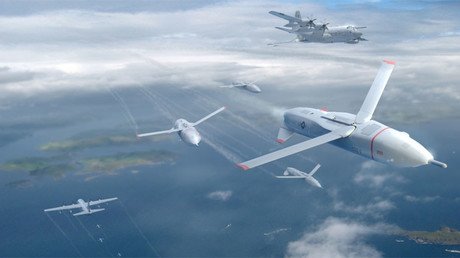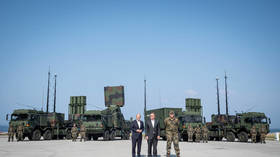DARPA's 'Aerial Dragnet' to monitor low-flying drones in urban areas

Amid the rise of drones, or small unmanned aerial systems, DARPA, the Pentagon's research arm, is developing technology "to provide persistent, wide-area surveillance of all UAS operating below 1,000 feet in a large city."
The program, known as Aerial Dragnet, is a new effort by the the Defense Advanced Research Projects Agency (DARPA) to track and counter small unmanned drones used in crowded urban areas. Though the program is targeted to aid US military forces' ability to "detect and identify such craft," the agency indicated last week that the technology will be used in the US.
"While Aerial Dragnet’s focus is on protecting military troops operating in urban settings overseas, the system could ultimately find civilian application to help protect US metropolitan areas from UAS-enabled terrorist threats," DARPA said in its announcement of the program.
Drones surveilling drones surveilling us surveilling each other https://t.co/lBXqW8d1Qr
— Ellie Robinson (@FollowEllie) September 16, 2016
On September 26, DARPA will hold a "Proposers Day" at the DARPA Conference Center in Arlington, Virginia, to facilitate discussion, information, and solicitation development among researchers interested in the program.
DARPA says Aerial Dragnet will basically be modeled on the air-traffic control system used in the US to track and monitor thousands of airplane flights each day.
"Commercial websites currently exist that display in real time the tracks of relatively high and fast aircraft—from small general aviation planes to large airliners—all overlaid on geographical maps as they fly around the country and the world," said Jeff Krolik, a DARPA program manager. "We want a similar capability for identifying and tracking slower, low-flying unmanned aerial systems, particularly in urban environments."
Understanding that UAS technology is increasingly affordable and widely available, and that "several systems are being developed for tracking small UAS," DARPA said urban environments are unique and deserve novel approaches that could offer non-line-of-sight tracking and advanced identification techniques.
For Aerial Dragnet, DARPA "envisions a network of surveillance nodes, each providing coverage of a neighborhood-sized urban area, perhaps mounted on tethered or long-endurance UAS. Using sensor technologies that can look over and between buildings, the surveillance nodes would maintain UAS tracks even when the craft disappear from sight around corners or behind objects."
The system would produce consistent updates of a low-level airspace's common operational picture, known as COP to DARPA. The data would then be "disseminated electronically to authorized users via secure data links."
For the program, DARPA is seeking experts in sensors, signal processing, and networked autonomy.
#DARPA researching camera technology that can see around walls https://t.co/vy5U1xjN9vpic.twitter.com/zKrv8Zxh5v
— RT America (@RT_America) August 4, 2016















